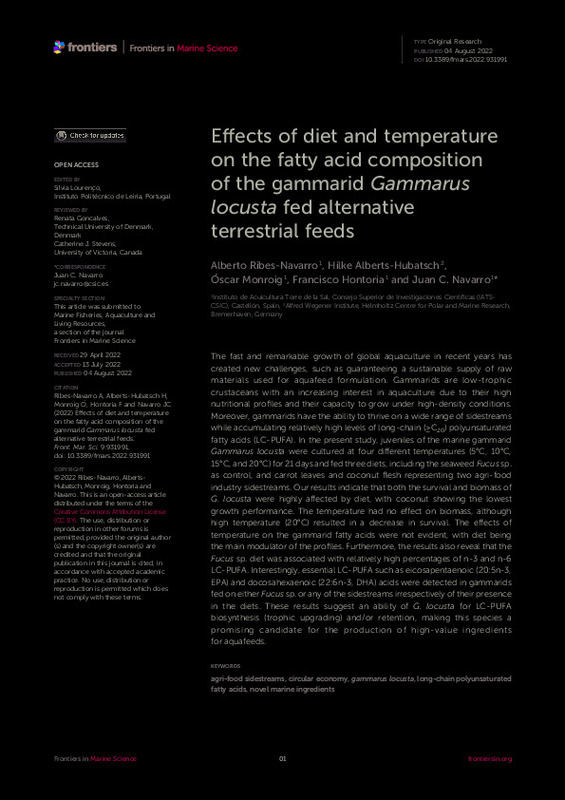JavaScript is disabled for your browser. Some features of this site may not work without it.
Buscar en RiuNet
Listar
Mi cuenta
Estadísticas
Ayuda RiuNet
Admin. UPV
Effects of diet and temperatureon the fatty acid composition of the gamarid Gammarus locusta fed alternative terrestrial feeds
Mostrar el registro sencillo del ítem
Ficheros en el ítem
| dc.contributor.author | Ribes-Navarro, Alberto
|
es_ES |
| dc.contributor.author | Alberts-Hubatsch, Hilke
|
es_ES |
| dc.contributor.author | Monroig, Óscar
|
es_ES |
| dc.contributor.author | Hontoria, Francisco
|
es_ES |
| dc.contributor.author | Navarro, Juan C.
|
es_ES |
| dc.date.accessioned | 2024-02-01T19:00:56Z | |
| dc.date.available | 2024-02-01T19:00:56Z | |
| dc.date.issued | 2022-08-04 | es_ES |
| dc.identifier.uri | http://hdl.handle.net/10251/202292 | |
| dc.description.abstract | [EN] The fast and remarkable growth of global aquaculture in recent years has created new challenges, such as guaranteeing a sustainable supply of raw materials used for aquafeed formulation. Gammarids are low-trophic crustaceans with an increasing interest in aquaculture due to their high nutritional profiles and their capacity to grow under high-density conditions. Moreover, gammarids have the ability to thrive on a wide range of sidestreams while accumulating relatively high levels of long-chain (>= C-20) polyunsaturated fatty acids (LC-PUFA). In the present study, juveniles of the marine gammarid Gammarus locusta were cultured at four different temperatures (5 degrees C, 10 degrees C, 15 degrees C, and 20 degrees C) for 21 days and fed three diets, including the seaweed Fucus sp. as control, and carrot leaves and coconut flesh representing two agri-food industry sidestreams. Our results indicate that both the survival and biomass of G. locusta were highly affected by diet, with coconut showing the lowest growth performance. The temperature had no effect on biomass, although high temperature (20 degrees C) resulted in a decrease in survival. The effects of temperature on the gammarid fatty acids were not evident, with diet being the main modulator of the profiles. Furthermore, the results also reveal that the Fucus sp. diet was associated with relatively high percentages of n-3 and n-6 LC-PUFA. Interestingly, essential LC-PUFA such as eicosapentaenoic (20:5n-3, EPA) and docosahexaenoic (22:6n-3, DHA) acids were detected in gammarids fed on either Fucus sp. or any of the sidestreams irrespectively of their presence in the diets. These results suggest an ability of G. locusta for LC-PUFA biosynthesis (trophic upgrading) and/or retention, making this species a promising candidate for the production of high-value ingredients for aquafeeds. | es_ES |
| dc.description.sponsorship | This research was supported by the ERA-NET BlueBio COFUND Project SIDESTREAM [Grant ID 68], cofunded through national funds provided by the Agencia Espanola de Investigacion, Spain, grant no. PCI2020-111960/MCIN/AEI/ 10.13039/501100011033 and the EU NextGenerationEU/ PRTR, and the Funding by the German Federal Ministry of Education and Research (BMBF), FKZ161B0950B. Additional funding was received through the project IMPROMEGA Agencia Espanola de Investigacion, Spain, grant no. RTI2018-095119-B-100, MCIU/AEI/FEDER/UE/MCIN/AEI/10.13039/ 501100011033/and FEDER "A way to make Europe." | es_ES |
| dc.language | Inglés | es_ES |
| dc.publisher | Frontiers Media SA | es_ES |
| dc.relation.ispartof | Frontiers in Marine Science | es_ES |
| dc.rights | Reconocimiento (by) | es_ES |
| dc.subject | Agri-food sidestreams | es_ES |
| dc.subject | Circular economy | es_ES |
| dc.subject | Gammarus locusta | es_ES |
| dc.subject | Long-chain polyunsaturated fatty acids | es_ES |
| dc.subject | Novel marine ingredients | es_ES |
| dc.title | Effects of diet and temperatureon the fatty acid composition of the gamarid Gammarus locusta fed alternative terrestrial feeds | es_ES |
| dc.type | Artículo | es_ES |
| dc.identifier.doi | 10.3389/fmars.2022.931991 | es_ES |
| dc.relation.projectID | info:eu-repo/grantAgreement/AEI/Plan Estatal de Investigación Científica y Técnica y de Innovación 2017-2020/PCI2020-111960/ES/CONVERSION DE DESECHOS DE ACUICULTURA Y AGRICULTURA EN INGREDIENTES PARA PIENSOS DE LA INDUSTRIA ACUICOLA MEDIANTE EL CULTIVO DE ORGANISMOS DE BAJO NIVEL TROFICO/ | es_ES |
| dc.relation.projectID | info:eu-repo/grantAgreement/AEI/Plan Estatal de Investigación Científica y Técnica y de Innovación 2017-2020/RTI2018-095119-B-I00/ES/ESTRATEGIAS INNOVADORAS PARA LA MEJORA DE LA BIOSINTESIS DE OMEGA-3 EN INVERTEBRADOS ACUATICOS PARA LA ACUICULTURA/ | es_ES |
| dc.relation.projectID | info:eu-repo/grantAgreement/EC/H2020/817992/EU | es_ES |
| dc.relation.projectID | info:eu-repo/grantAgreement/BMBF//FKZ161B0950B/ | es_ES |
| dc.rights.accessRights | Abierto | es_ES |
| dc.description.bibliographicCitation | Ribes-Navarro, A.; Alberts-Hubatsch, H.; Monroig, Ó.; Hontoria, F.; Navarro, JC. (2022). Effects of diet and temperatureon the fatty acid composition of the gamarid Gammarus locusta fed alternative terrestrial feeds. Frontiers in Marine Science. 9:1-11. https://doi.org/10.3389/fmars.2022.931991 | es_ES |
| dc.description.accrualMethod | S | es_ES |
| dc.relation.publisherversion | https://doi.org/10.3389/fmars.2022.931991 | es_ES |
| dc.description.upvformatpinicio | 1 | es_ES |
| dc.description.upvformatpfin | 11 | es_ES |
| dc.type.version | info:eu-repo/semantics/publishedVersion | es_ES |
| dc.description.volume | 9 | es_ES |
| dc.identifier.eissn | 2296-7745 | es_ES |
| dc.relation.pasarela | S\470336 | es_ES |
| dc.contributor.funder | European Commission | es_ES |
| dc.contributor.funder | Agencia Estatal de Investigación | es_ES |
| dc.contributor.funder | European Regional Development Fund | es_ES |
| dc.contributor.funder | Bundesministerium für Bildung und Forschung, Alemania | es_ES |








